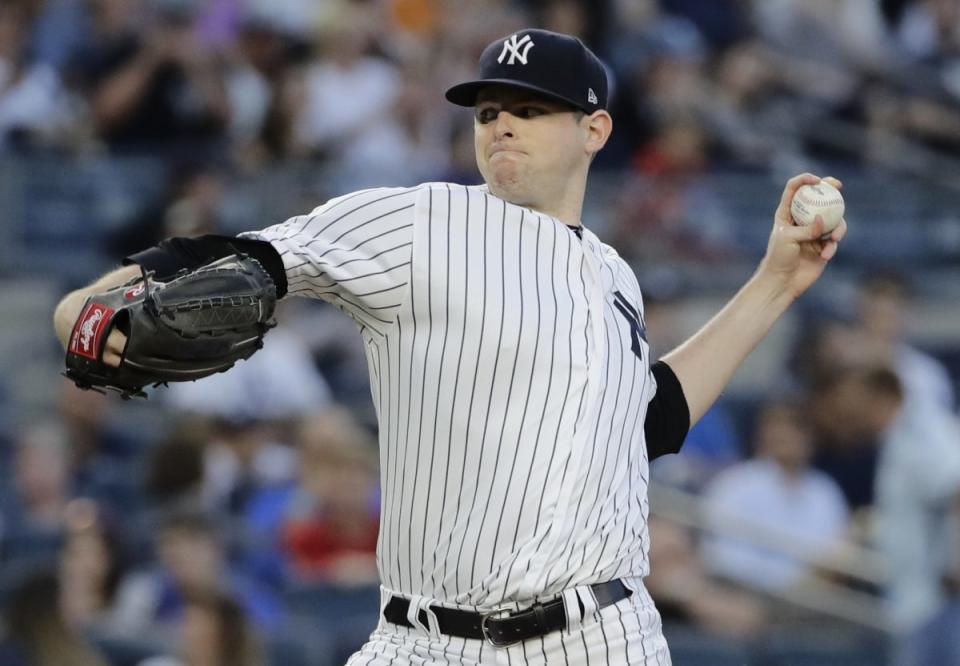Fantasy pitchers worth adding because of their two-strike mastery

After getting ahead of hitters with fastball command, the ability to finish them off either via a weak batted ball or a strikeout is the most important weapon for a good pitcher.
So this week, we’re going to look at select leaders and trailers in the statistic while also noting their Yahoo ownership percentages. And since this stat isn’t publicly available but provided to us courtesy of our friends at MLB-stat provider Inside Edge, we also have a more complete list of all leaders and trailers in the statistic. Of course, generally, the great pitchers are good at this and the bad ones struggle. But that’s how you know you have a good stat — just a handful of outliers/surprises in each direction.
For context, note that when a pitcher gets two strikes on a hitter, he retires the batter 76% of the time. But the range this year among all 92 pitchers with at least 1,000 pitches through Monday is 84% (Chris Sale) to 64% (Kevin Gausman).
[Fantasy Football is open! Sign up now]
I’m looking at the pitchers at 78% or better being “good” at finishing off hitters and 71% or worse as “bad.” All the pitchers in between I have omitted from the master list because the variance is not significant enough to be meaningful.
The first surprising name that pops up is someone owned in 84% of Yahoo leagues. But the criticism of him in the past is that he couldn’t really finish off hitters. Now, Mike Leake is retiring 82% of hitters with two strikes vs. 76% last year (about average). The trouble is that I can’t find anything else on his report card that suggests WHY he’s better at this. But Leake deserves a longer leash in all formats.
The other players are more widely available. Eduardo Rodriguez is unowned in more than half of leagues mostly because he’s on the DL (knee). He’s not due back for a few weeks but if you have a DL spot open, pick him up (finishes off 80% of hitters, 11th).
A pitcher I just picked up in Friends and Family is Jordan Montgomery. He has great swing-and-miss to his game and as a result is 15th in the statistic, ahead of luminaries like Stephen Strasburg and Clayton Kershaw, finishing off 79% of batters when having them in a two-strike hole. He’d be my No. 1 add in all formats, especially given how the Yankees offense has rebounded after a historic slump (10 straight games with 8 hits or less) the last two weeks of May.
But if you fail there, Zack Wheeler (37% owned, 78% hitters finished off), Edinson Volquez (48%, 78%) and Ariel Miranda (52%, 78%) may be available.
On the other end of the spectrum, you don’t want to wait around for pitchers who may not rebound in the near term. For example, Gausman is owned still in 48% of leagues. That’s nuts. Most have waived Derek Holland who was defying peripherals for a while but is no longer, though Holland is still owned in 34% of leagues. That number, I assure you, should be zero. The league’s OBP with two strikes against Holland is not quite Gausman bad but is still .320.
But almost everyone is holding on to a trio of starters we once had great hopes for but who are struggling mightily: Julio Teheran, Jose Quintana and Justin Verlander. They rank 85th, 84th and 80th among the 92 qualifiers. Last year they were 13th, 30th and 9th (of 141 pitchers with at least 1,500 pitches). Given the respective collapses in this statistic, it seems more like fact than fluke to me. Remember, it’s not just the size of the sample but the weight of it, too.
Finally, a little housekeeping from last week’s story. Some commenters wanted me to combine the analysis on changes in batter strikeout rate with another layer of analysis of batter well-hit rate. I don’t do that typically for two reasons. Primarily, the problem of overfitting: If you combine guys who have improved their contact rate with the guys who have improved their well-hit rate, you’re just going to get the list of the best hitters. It’s purely describing good hitting and not using a statistic to predict it. In other words, there won’t be enough (any?) outliers (guys who are hitting for a poor average relative to their personal history despite improving their contract rate and having a good well-hit rate).
Also we want to deal with one stat at a time here, for clarity. Sure, we’ll combine strikeouts and walks into one statistic occasionally. But switching gears to another completely separate stat is just too confusing. I worry though that some extrapolate my focusing on one stat in each of these pieces to mean each week that: “This the one stat that matters!” There is no one stat. Each is a tool in the toolbox, which helps us hopefully project players more accurately in different ways and opens our minds to other analytical approaches.



